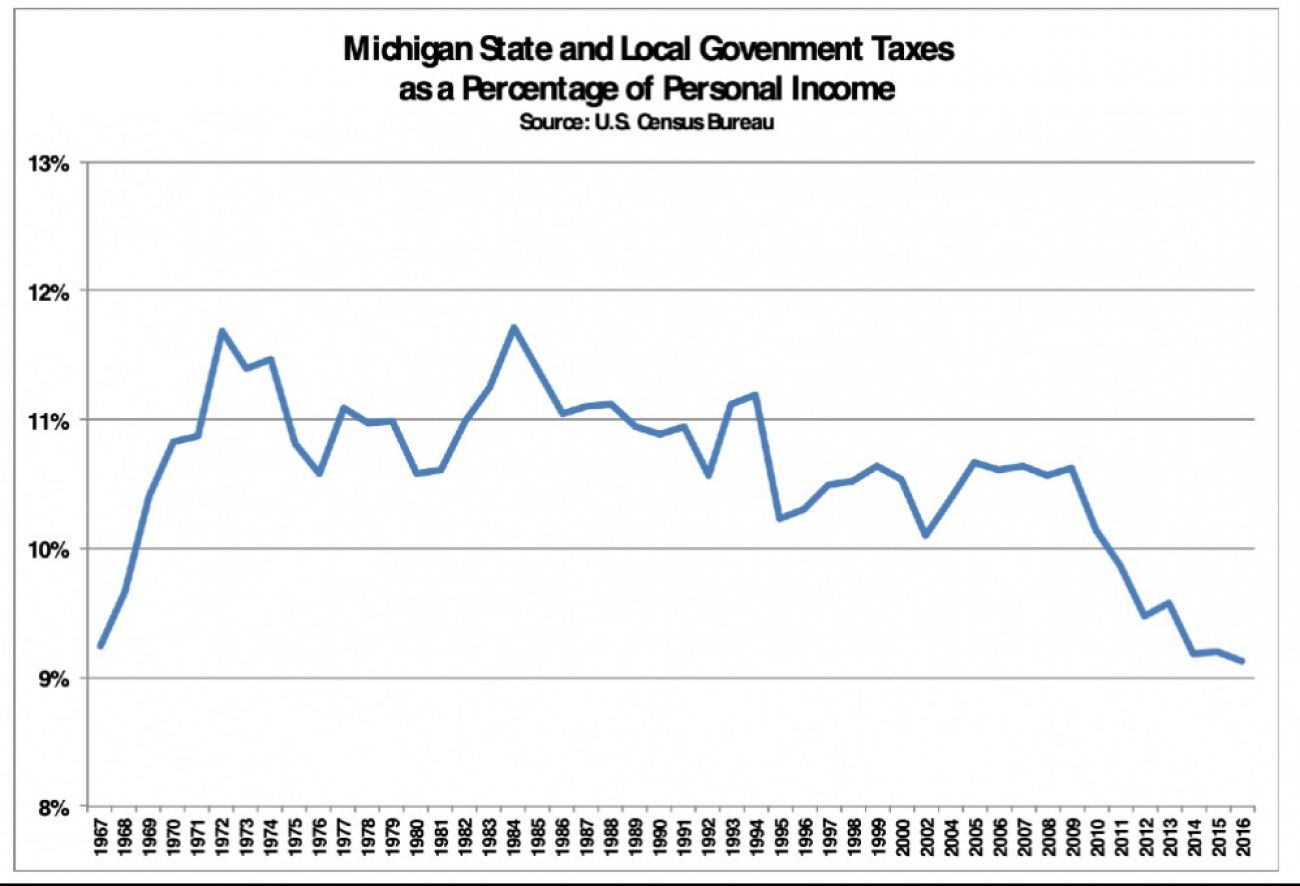Opinion | Is it time to increase taxes in Michigan?

As the governor and Legislature continue to work on a new state government budget, one fundamental question is whether additional resources, especially taxes, are required. This issue influences decisions not just about road funding, but also funding for K-12 schools, higher education, Medicaid, support for local governments as well as other aspects of state finance. Some fiscal facts can be informative.
The overall effective tax rate in Michigan – all taxes as a percentage of total income – is the lowest it has been in more than 50 years. The long-run trend of all state and local government taxes together (property, sales, income, business, gasoline, tobacco, and so on) as a percentage of total personal income in the state is shown in the figure. The chart begins in 1967, when the state government personal income tax first took effect. In 2016, all state and local taxes represented 9.12 percent of income, the lowest since 1967 (when it was 9.24 percent).

In the first years after adoption of the income tax, taxes grew faster than income. The level of taxes peaked at 11.7 percent of income in 1972 and then again in 1984. Since 1984, the overall trend has seen a decrease, with total state and local government taxes not keeping pace with total income in the state. Simply put, taxpayers in Michigan now have the lowest effective rate of taxation in 50 years. And that decrease has been particularly substantial in recent years since the end of the Great Recession. In 2009, total taxes amounted to 10.6 percent of income compared to 9.1 percent in 2016.
Comparing overall taxes to total income is the most telling measure of the level of taxation, partly because all taxes from all levels of government in Michigan (state, county, city, township, school district and so on) are included. Even more importantly, total income received by people in the state reflects the resources that taxpayers have available and ultimately determines what goods and services citizens demand – including the demand for services provided through government. If citizens demand more services – better roads, improved schools, safe water systems – then taxes have to rise to pay the cost.
Other tax measures tell a similar story. The real (inflation adjusted) tax amount per person in 2000 was about $4,400. By 2016, the total tax amount per person had decreased to about $4,080, a decline of nearly 8 percent. To put it another way, between 2000 and 2016, total taxes in Michigan did not keep pace with population change and inflation.
Not only has the effective tax rate in Michigan been declining; in addition the overall effective tax rate in Michigan is low compared to other states. In 2016, 31 states had higher tax rates than in Michigan, including all of the Midwestern states except Indiana. The effective tax rate in Michigan is less than in Illinois, Minnesota, Iowa, Ohio, Pennsylvania, and Wisconsin for example.
If the tax rate in Michigan had even been just equal to the national average (9.92 percent as opposed to our current 9.12), governments in the state would have added nearly $3.7 billion of additional revenue in 2016. This would provide resources not only to fix the roads, but also address financial issues of K-12 schools, old water and sewer systems, outstanding pension obligations, and other crucial public services. Such a tax rate would be equal to what we had in 2011 – and still less than any prior year back to 1969!
Taxes in Michigan are low compared to historical levels in the state, have been declining relative to income for almost the last decade, and are low relative to other states. So, if we want quality services, higher taxes seem appropriate and perhaps necessary. One can disagree about how best to do that – increased gas taxes or a progressive income tax or a higher sales tax or road use fees or some other option. However, the first law of economics seems to apply: “ain’t no free lunch.”
The views expressed are the author’s alone and do not necessarily represent the views of Michigan State University or its officials.
See what new members are saying about why they donated to Bridge Michigan:
- “In order for this information to be accurate and unbiased it must be underwritten by its readers, not by special interests.” - Larry S.
- “Not many other media sources report on the topics Bridge does.” - Susan B.
- “Your journalism is outstanding and rare these days.” - Mark S.
If you want to ensure the future of nonpartisan, nonprofit Michigan journalism, please become a member today. You, too, will be asked why you donated and maybe we'll feature your quote next time!







